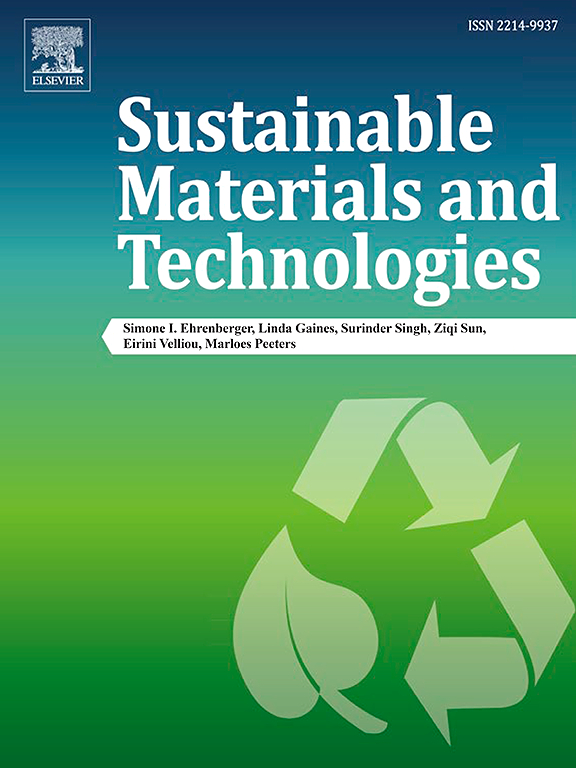Sustainable functional electrospun polyamide 11/halloysite derivatives nanofibrous membranes for water treatment applications
IF 8.6
2区 工程技术
Q1 ENERGY & FUELS
引用次数: 0
Abstract
Membrane-based approaches are an exciting alternative for the filtration and remediation of polluted water and for the removal of different traditional and emerging contaminants. This work focuses on the design and development of sustainable bio-polymeric blends based on polyamide 11 (PA11) employed to produce different Electrospun Nanofiber Membranes (ENMs) through the electrospinning process. Moreover, different eco-friendly functional nanofillers based on hybrid halloysite (HNT) derivatives were employed as dopant agents of the starting polymeric blends in a ratio of 1, 2 and 5 wt% of PA11 to achieve better mechanical and thermal features as well as retention performances of specific wastewater organic contaminants. Chemical-physical and structural-morphological characterizations, concerning all the nanofillers and the obtained sustainable membranes, are reported as well as the removal and separation studies of two selected anionic and cationic dyes, methyl orange (MO) and methylene blue (MB) in a dead-end filtration apparatus. The newly developed composite ENMs, compared to pristine PA11 ones, show good tensile mechanical and thermal properties, and increased MO and MB removal rates, modulated by the different HNT derivatives employed. Dead-end filtration experiments were performed using 1 and 3 layers of each type of ENM revealing, for 1-layer PA11 ENMs containing HNT modified with octadecylphosphonic acid and (3-aminopropyl)triethoxysilane (PA11@C18_HNT_NH2) and dimethyloctadecyl[3(trimethoxysilyl)propyl]ammoniumchloride (PA11@HNT_N + C18), a selectivity towards the removal of the cationic dye MB with a separation efficiency of 69.8 and 73.3 % respectively. Hence, 3-layer PA11 ENMs doped with HNT functionalized with (3-aminopropyl)triethoxysilane (PA11@HNT_NH2) display the highest retention rate for MO and MB respectively of 100 and 89.8 %.

可持续功能电纺聚酰胺11/高岭土衍生物纳米纤维膜的水处理应用
膜为基础的方法是一个令人兴奋的替代过滤和修复污染的水和去除不同的传统和新兴污染物。本研究的重点是设计和开发基于聚酰胺11 (PA11)的可持续生物聚合物共混物,通过静电纺丝工艺生产不同的静电纺纳米纤维膜(ENMs)。此外,基于杂化高岭土(HNT)衍生物的不同生态友好型功能纳米填料以PA11的比例为1、2和5 wt%作为起始聚合物共混物的掺杂剂,以获得更好的机械和热特性以及对特定废水有机污染物的保留性能。报道了所有纳米填料和获得的可持续膜的化学-物理和结构-形态学表征,以及在终端过滤装置中对两种选定的阴离子和阳离子染料甲基橙(MO)和亚甲基蓝(MB)的去除和分离研究。与原始的PA11相比,新开发的复合enm表现出良好的拉伸力学和热性能,并且通过使用不同的HNT衍生物来调节MO和MB的去除率。对每种类型的ENM分别进行了1层和3层的终端过滤实验,结果表明,对于含有十八烷基膦酸和(3-氨基丙基)三乙氧基硅烷(PA11@C18_HNT_NH2)和二甲基十八烷基[3(三甲氧基硅基)丙基]氯化铵(PA11@HNT_N + C18)改性的HNT的一层PA11 ENM,对阳离子染料MB有选择性去除,分离效率分别为69.8%和73.3%。因此,以(3-氨基丙基)三乙氧基硅烷(PA11@HNT_NH2)功能化的HNT掺杂的3层PA11 enm对MO和MB的保留率最高,分别为100%和89.8%。
本文章由计算机程序翻译,如有差异,请以英文原文为准。
求助全文
约1分钟内获得全文
求助全文
来源期刊

Sustainable Materials and Technologies
Energy-Renewable Energy, Sustainability and the Environment
CiteScore
13.40
自引率
4.20%
发文量
158
审稿时长
45 days
期刊介绍:
Sustainable Materials and Technologies (SM&T), an international, cross-disciplinary, fully open access journal published by Elsevier, focuses on original full-length research articles and reviews. It covers applied or fundamental science of nano-, micro-, meso-, and macro-scale aspects of materials and technologies for sustainable development. SM&T gives special attention to contributions that bridge the knowledge gap between materials and system designs.
 求助内容:
求助内容: 应助结果提醒方式:
应助结果提醒方式:


